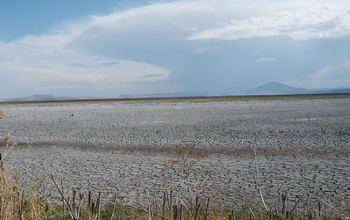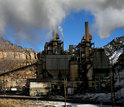News Release 15-055
Drought, heat likely to affect U.S. West's power grid
Scientists recommend looking at power plants' capacities in view of expected changes

Expected increases in drought will affect the U.S. power grid, scientists have found.
May 18, 2015
This material is available primarily for archival purposes. Telephone numbers or other contact information may be out of date; please see current contact information at media contacts.
Find related stories on NSF's geosciences risk and resilience interest area at this link.
Electricity generation and distribution infrastructure in the U.S. West should be "climate-proofed" to decrease the risk of future power shortages, according to new research results.
Expected increases in extreme heat and drought will bring changes in precipitation, air and water temperatures, air density and humidity, write scientists Matthew Bartos and Mikhail Chester of Arizona State University in a paper published in the current issue of the journal Nature Climate Change.
The research was funded by the National Science Foundation (NSF) Water, Sustainability and Climate (WSC) Program.
"Society depends on agriculture, energy and water availability to prosper," said Tom Torgersen, NSF WSC program director. "Security in these areas requires an understanding of the complex links between humans and nature."
Changing conditions could limit energy production
The authors say that changing conditions could significantly constrain the energy generation capacity of power plants--unless steps are taken to upgrade systems and technologies to withstand the effects of a generally hotter and drier climate.
The scientists report that power stations are particularly vulnerable to the climate conditions predicted to occur within the next half-century.
"In their development plans, power providers are not taking into account climate change effects," Bartos said. "They are likely overestimating their ability to meet future electricity needs."
U.S. West will see higher demand in years to come
The U.S. West in particular is expected to see greater energy demand due to population growth and higher temperatures.
Bartos and Chester say that power plants should strengthen their transmission capacities and conservation strategies if they are to remain capable of reliably supplying power as conditions change.
Scientists recommend that power providers consider climate constraints
Power providers also should invest in more resilient renewable energy sources and consider local climate constraints when selecting sites for new generation facilities, the researchers said.
"Diverse arrays of energy-generation technologies are used by the U.S. West's power grid," said Chester.
The scientists looked at five power-generating technologies: hydroelectric facilities, steam, wind and combustion turbines, as well as photovoltaics.
"We're finding that some power generation technologies may be more climate-resilient than others," Chester said.
"Renewable energy sources are generally less susceptible to climate change effects. More use of renewable sources may contribute to a better climate-proofed power infrastructure."
-NSF-
-
Extreme heat may increase the risk of future power shortages.
Credit and Larger Version -
Society depends on agriculture, energy and water availability to prosper, say scientists.
Credit and Larger Version -
Changing conditions could significantly constrain power plants' energy generation capacities.
Credit and Larger Version -
Researchers have found that power plants in the U.S. West need to plan for a hotter, drier climate.
Credit and Larger Version -
As with the American West, the U.S. East's power grid may be vulnerable to climate variability.
Credit and Larger Version
Media Contacts
Cheryl Dybas, NSF, (703) 292-7734, email: cdybas@nsf.gov
Joe Kullman, ASU, (480) 965-8122, email: joe.kullman@asu.edu
Related Websites
NSF Grant: WSC: Advancing Infrastructure and Institutional Resilience to Climate Change for Coupled Water-Energy Systems: http://www.nsf.gov/awardsearch/showAward?AWD_ID=1360509&HistoricalAwards=false
NSF Water, Sustainability, and Climate Discovery Article Series: http://www.nsf.gov/discoveries/disc_summ.jsp?cntn_id=128398
NSF News: NSF and NIFA award $25 million in grants for study of water sustainability and climate: http://www.nsf.gov/news/news_summ.jsp?cntn_id=132501
The U.S. National Science Foundation propels the nation forward by advancing fundamental research in all fields of science and engineering. NSF supports research and people by providing facilities, instruments and funding to support their ingenuity and sustain the U.S. as a global leader in research and innovation. With a fiscal year 2023 budget of $9.5 billion, NSF funds reach all 50 states through grants to nearly 2,000 colleges, universities and institutions. Each year, NSF receives more than 40,000 competitive proposals and makes about 11,000 new awards. Those awards include support for cooperative research with industry, Arctic and Antarctic research and operations, and U.S. participation in international scientific efforts.
Connect with us online
NSF website: nsf.gov
NSF News: nsf.gov/news
For News Media: nsf.gov/news/newsroom
Statistics: nsf.gov/statistics/
Awards database: nsf.gov/awardsearch/
Follow us on social
Twitter: twitter.com/NSF
Facebook: facebook.com/US.NSF
Instagram: instagram.com/nsfgov







